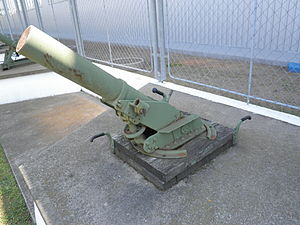
The Panzerbüchse 39, abbreviated PzB 39, was a German anti-tank rifle used in World War II. It was an improvement of the Panzerbüchse 38 rifle.

The Škoda 30.5 cm Mörser M.11 was a siege howitzer produced by Škoda Works and used by the Austro-Hungarian Army during World War I and by Nazi Germany in World War II.

The Stokes mortar was a British trench mortar designed by Sir Wilfred Stokes KBE that was issued to the British and U.S. armies, as well as the Portuguese Expeditionary Corps, during the later half of the First World War. The 3-inch trench mortar is a smooth-bore, muzzle-loading weapon for high angles of fire. Although it is called a 3-inch mortar, its bore is actually 3.2 inches or 81 mm.
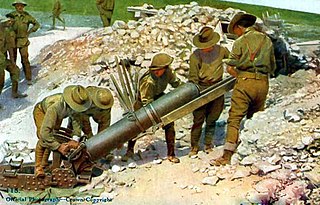
The ML 9.45 inch Heavy Trench Mortar, nicknamed the Flying Pig, was a large calibre mortar of World War I and the standard British heavy mortar from the autumn of 1916. It was a modification of an original French design, the Mortier de 240 mm developed by Batignolles Company of Paris and introduced in 1915. Britain manufactured the modified version under licence.

The 240 mm Trench Mortar, or Mortier de 240 mm, was a large calibre mortar of World War I. An original French design, it was developed by Batignolles Company of Paris and introduced in 1915.

The 10 cm Nebelwerfer 40 was a heavy mortar used by Germany during the Second World War. Much like the American M2 4.2 inch mortar it was intended to deliver chemical munitions, such as gas and smoke shells, as well as ordinary high-explosive shells. It was derived from Rheinmetall's Nebelwerfer 51 and 52 prototypes of the late Thirties which were attempts to develop a more accurate and longer-ranged mortar than the 10 cm Nebelwerfer 35. The NbW 40 is one of the better examples of German overengineering since it fired a slightly heavier bomb over twice as far as the NbW 35, but weighed almost eight times more than the earlier model.

The 22.5 cm Minenwerfer M 15 was a heavy mortar used by Austria-Hungary in World War I. It was developed by Böhler as an alternative to the German Ehrhardt 25 cm schwere Minenwerfer which Böhler was having problems building under license. It was a muzzle-loading, smooth-bore mortar that had no recoil system whatsoever. The entire mortar had to be levered around to aim at new targets. It was not particularly accurate and bombs often fell over in flight and landed on their sides which caused a lot of duds in soft ground. It fired high-explosive and gas shells. For transport two wheels from the Gebirgsgechütz M 99 were used.

The 15 cm Luftminenwerfer M 15 M. E. was a medium mortar used by Austria-Hungary in World War I. It was developed by the German firm Maschinenfabrik Esslingen in response to a German requirement. Its initial testing was observed by an Austro-Hungarian representative and his positive report convinced them to order a batch of five for comparative testing. It was evaluated on 21 September 1915 and it produced the right impression. Nonetheless four weapons were sent off for combat trials at the end of October 1915, which were presumably favorable.

The 12 cm Luftminenwerfer M 16 was a medium mortar used by Austria-Hungary in World War I. It was developed by Austria Metal Works in Brno from their earlier, rejected, 8 cm project. It was a rigid-recoil, smooth-bore, breech-loading design that had to be levered around to aim at new targets. It was very simple in that the shell closed the top of the chamber and was retained by a "gripper" until the air pressure was deemed sufficient and the gripper was manually released, which fired the weapon. An additional barrel could be fitted to extend the range. A cylinder of compressed air was good for eleven shots.

The 20 cm Luftminenwerfer M 16 was a heavy mortar used by Austria-Hungary in World War I. It was developed by Austria Metal Works in Brno from their earlier 12 cm Luftminenwerfer M 16. It was a rigid-recoil, smoothbore, breech-loading design that had to be levered around to aim at new targets. It was very simple in that the shell closed the top of the chamber and was retained by a "gripper" until the air pressure was deemed sufficient and the gripper was manually released, which fired the weapon. The barrel was fixed at 45° elevation and range was adjusted by varying the air pressure, but an additional barrel could be fitted to extend the range. A single cylinder of compressed air was only good for four to six shots. It was loaded onto a two-wheel cart for transport.

The 8 cm Feldkanone M.5 was a field gun used by Austria-Hungary during World War I. It was a conventional design, with its most notable feature being its obsolescent autofrettaged bronze barrel, necessary because Austria-Hungary still had trouble making steel of the proper quality. Its development was quite prolonged as the Austrians took years to decide on the proper recoil system and type of breech. Even then production difficulties prevented its introduction into service until 1907.

The 24 cm Mörser M 98 was a heavy siege howitzer used by Austria-Hungary during World War I. It was designed to attack modern fortifications, but its short range and ineffective ammunition led to the development of the more deservedly famous 30.5 cm Mörser M 11 and M 16.

The 9 cm Minenwerfer M 14 was a light mortar used by Austria-Hungary in World War I. It was designed by the Army's own Technisches und Administratives Militär-Komitee (TMK) in an effort to quickly satisfy the demand from the front for a light mortar. It had a number of issues with its ammunition, namely the black powder used as a propellant gave off copious smoke clouds on firing that revealed the tube's location and the mortar bomb fuzes had a high rate of failure. The breech-loading mortar tube was mounted on a framework that didn't allow for any traverse, which meant that it was impossible to engage different targets without relaying the mortar. In turn the frame was mounted a rectangular firing platform.
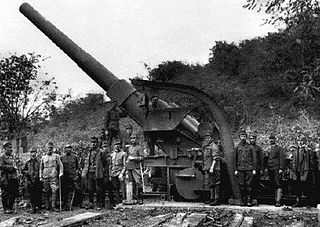
The 24 cm Kanone M. 16 was a super-heavy siege gun used by Austria-Hungary during World War I and by Nazi Germany during World War II. Only two were finished during World War I, but the other six were completed in the early twenties and served with the Czechoslovak Army until they were bought by the Germans after the German occupation of Czechoslovakia in 1938. During World War I, one gun served on the Western Front and the other on the Italian Front. During World War II, they saw action in the Battle of France, Operation Barbarossa and the Siege of Leningrad.

The 9.15 cm leichtes Minenwerfer System Lanz was a light mortar used by Germany and Austria-Hungary in World War I. It was a smooth-bore, breech-loading design that used smokeless propellant. It was chosen by the Austrians as an interim replacement for their 9 cm Minenwerfer M 14, pending development of a superior domestic design, which eventually turned out to be the 9 cm Minenwerfer M 17. The older Austrian design had a prominent firing signature, a less effective bomb and shorter range than the Lanz. Over 500 were ordered with deliveries beginning in April 1917.
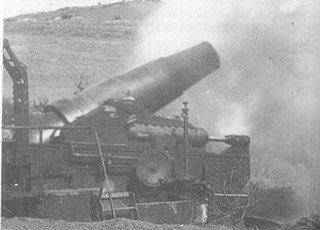
The 28 cm Haubitze L/12 was a German coastal defense and siege howitzer. Developed by Krupp before World War I that saw service in both World War I and World War II.
The 8 cm minomet vz. 36 was a medium mortar designed by the Škoda Works during the Thirties. Intended as standard medium infantry mortar for the Czechoslovak Army all available weapons were impressed into service by the German Army when they occupied Bohemia-Moravia in March 1939 and the Slovaks seized approximately one hundred fifty when they declared independence from Czechoslovakia at the same time. Slovak weapons saw combat in the Slovak-Hungarian War, the invasion of Poland, the opening months of Operation Barbarossa and the Slovak National Uprising.
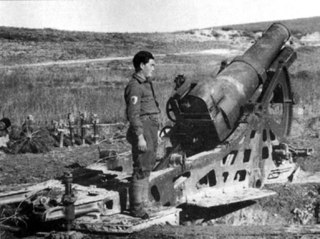
The Mortaio da 260/9 Modello 16 - was an Italian Heavy mortar and Siege Gun designed by the French Schneider Company and produced under license in Italy by Ansaldo and Vickers-Terni for the Italian Army. It was used by the Italian Army during both the First World War and Second World War.

The 21 cm Versuchmörser 06 was an experimental German howitzer which served in limited numbers during World War I.

The 28 cm Haubitze L/14 in Räderlafette was a prototype German siege howitzer which served during World War I.
